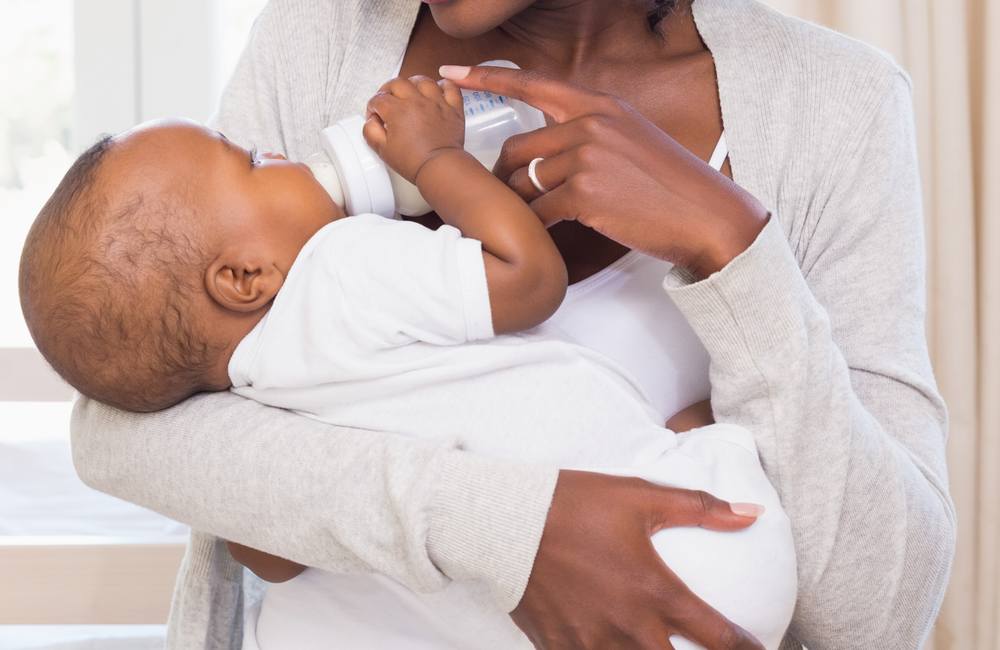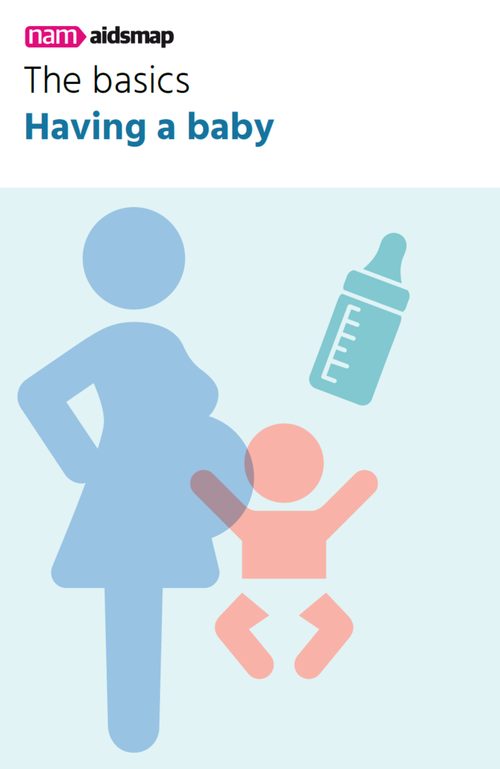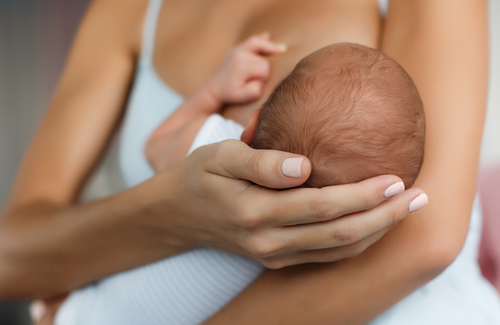
Key points
- The risk of HIV transmission to the baby is zero when using formula milk.
- U=U does not apply to breastfeeding, but the risk of HIV transmission is lower if you have an undetectable viral load.
- Guidelines on infant feeding vary according to the context in which you live to ensure the best chance of survival for your child.
The medical advice given to women living with HIV about infant feeding has changed many times over the past 20 years and is likely to continue to evolve. It reflects our increased understanding about the science of HIV transmission as well as advances in HIV treatment.
The advice given also differs according to where you live. In the UK and other high-income countries, the safest way for a mother living with HIV to feed her baby is to bottle feed using formula milk. In low income countries however, you may be advised to breastfeed. This is because overall it is safer for a child to have breast milk containing HIV than infant formula made with unsafe water and bottles that have not been sterilised.
However, even in places where infant formula is officially recommended, mothers living with HIV may still be supported to breastfeed by healthcare professionals in certain circumstances, if they are on effective treatment and agree to more frequent check-ups and to follow medical advice.
What is the risk of passing on HIV to your baby during feeding?
If you use formula feeding, the risk of HIV transmission is zero. In the UK and other countries where women can formula feed safely, you are advised only to feed your baby with formula milk from birth.
If you have been on treatment for a while and it is working well, the risk during breastfeeding is low. It does however depend on your viral load, your own state of health, your baby’s health and how long you breastfeed the child. Breastfeeding is only recommended where formula feeding is not considered safe, for example in low income countries.
Taking antiretroviral treatment substantially lowers the risk of passing on HIV through breast milk. Some estimates put the risk of transmission after birth at 1% if a woman breastfeeds for six months, and at almost 3% if she breastfeeds for one year. In most of the studies on which these figures are based however, not all the women were taking treatment for the whole time they were breastfeeding. The more recent PROMISE study, in which mothers received HIV treatment for the entire time of breastfeeding, estimated the risk of transmission at 0.3% after six months of breastfeeding and 0.6% after 12 months. Higher viral loads were associated with a greater risk of transmission. This study found two cases of babies acquiring HIV despite their mothers having an undetectable viral load at the time.
If neither you nor your baby are on HIV treatment, it has been estimated that over two years of breastfeeding there is around a 20% chance of the child acquiring HIV. Giving food, formula or water in addition to breast milk (known as ‘mixed feeding’) in the absence of treatment does not lower the risk but makes HIV transmission more likely.
More research is needed to find out how long you need to have been on treatment for before starting breastfeeding, as well as the impact of adherence and viral load on transmission. All the research on breastfeeding and HIV has been done in low-income countries and there has been no research on breastfeeding and HIV in the UK.
What is formula feeding?
For all babies, the only recommended alternative to breastfeeding for the first six months of their life is infant formula, also known as formula milk, given by bottle. Babies should not be offered solid food until they are six months old.
Infant formula is made from cow’s milk that has been treated to make it more suitable for babies. It usually comes in the form of a dry powder that has to be made up with water that has been boiled and cooled (not bottled water). Ready-to-feed liquid formula is also available but is more expensive and once opened must be used quickly.
Good hygiene is very important when making up a formula feed because a baby's immune system is not as strong as an adult’s. Diarrhoea and vomiting caused by bacteria are dangerous for newborns.
To avoid infection, there are a few things you must do:
- Clean bottles, teats and any other feeding equipment in hot soapy water as soon as possible after feeds using clean bottle brushes. Do not use salt. Putting feeding equipment through the dishwasher will clean it but it does not sterilise it. Before sterilising, rinse everything in clean cold running water.
- Sterilise the bottles and teats either by using a cold-water sterilising solution, steam sterilising (for example in a microwave container) or boiling. Before handling sterilised equipment wash and dry your hands and assemble the bottles on a clean disinfected surface.
- Make up feeds one at a time as needed. Even when tins and packets of powdered infant formula are sealed, they can sometimes contain bacteria that multiply very quickly at room temperature. Even when a feed is kept in a fridge, bacteria can still survive and multiply, although more slowly.
- Use freshly boiled drinking water from the tap to make up a feed. Do not use artificially softened water or water that was boiled earlier. Leave the water to cool in the kettle for no more than 30 minutes. Then it will stay at a temperature of at least 70C. Water at this temperature will kill any harmful bacteria.
Bottled water is not recommended for making up feeds, as it's not sterile and may contain too much salt (sodium) or sulphate. However, you may need to use bottled water to make up a feed if drinking the local tap water is not recommended. If you have to use bottled water to make up a feed:
- Check the label to make sure the water contains:
- less than 200mg a litre of sodium (also written as Na)
- less than 250mg a litre of sulphate (also written as SO4).
- Boil it like tap water at a temperature of at least 70C before you prepare the feed.
Step-by-step instructions are available on the NHS website.
Why is the advice different according to where you live in the world?
British, European and US medical guidelines state that formula milk is safer than breastfeeding if you are living with HIV. However, the World Health Organization states that this is not the case for mothers living in places where children are at high risk of diarrhoea, pneumonia and malnutrition. In many low-income countries, around one in twenty babies die before their first birthday, often due to these conditions. Breastfeeding provides essential protection against diarrhoea, pneumonia and malnutrition.
The risk of HIV transmission (low if your HIV treatment is working well) must be balanced against the risk of other serious illnesses.
Formula milk is a breast milk substitute that provides babies with the nutrients they need to grow and develop. However, it has three main disadvantages which are particularly relevant in some parts of the world.
Firstly, because formula is given to the baby using bottles, there is always a risk of bacteria that can cause diarrhoea and vomiting if you don’t have access to clean drinking water and sterilisation.
Secondly, formula can't strengthen your baby’s immune system in the way that breast milk can. In many poorer parts of the world, breastfeeding significantly reduces infant deaths by protecting against dangerous infections such as pneumonia.
Thirdly, there is a considerable expense associated with formula feeding, including the purchase of sterilising equipment and bottles. Many women on low incomes, whether in the UK or elsewhere, struggle to afford this.
World Health Organization guidelines on HIV and infant feeding
The World Health Organization (WHO)/United Nations Children’s Fund (UNICEF) Guidelines on HIV and Infant Feeding were most recently updated in 2016. These guidelines are intended mainly for countries in Africa and Asia with high HIV prevalence and settings in which diarrhoea, pneumonia and undernutrition are common causes of infant and child deaths.
The 2016 recommendations state that mothers living with HIV should exclusively breastfeed their babies for six months, then introduce appropriate complementary foods and continue breastfeeding up to at least the child’s first birthday. This is similar to the advice for women in the general population. During this time mothers should be fully supported to adhere to their HIV treatment by their healthcare team.
Although there is still some risk of passing HIV to their babies, mothers living with HIV are advised that breastfeeding provides a better chance of surviving than when using infant formula. Babies fed with formula milk in these countries have a greater risk of diarrhoea, pneumonia and malnutrition. Breastfeeding provides many short- and long-term health benefits to both mother and child and plays an important role in child development.
Infant feeding advice for women with HIV living in the UK
In the UK and other countries where women can formula feed safely, you are advised only to feed your baby with formula milk from birth.
The most recent guidelines from the British HIV Association (BHIVA) state that in the UK and other high-income settings, the safest way to feed infants born to women with HIV is with formula milk, as this means there is zero risk of ongoing HIV exposure after birth. BHIVA therefore recommends that women living with HIV feed their babies with formula.
BHIVA also recommends that women who need it should be given free formula milk, although in fact it is not available in all areas. Ask your healthcare team or support organisation if you have difficulty meeting the cost of formula and the equipment needed, as financial and other help may be available.
When mothers do not breastfeed their breasts still produce milk, which can be very uncomfortable and may cause distress. The recommendations therefore state that women living with HIV who do not breastfeed should be offered medication within 24 hours of delivery that suppresses milk production to ease the discomfort.
Feeding time can still be an occasion for bonding with your baby. Holding your baby ‘skin to skin’, with no clothes between you, while you are feeding him or her, can help you feel close to your baby and is recommended, particularly in the early days.
Some women can be disappointed that they cannot breastfeed. They may also find it difficult to explain to family and friends why they are not breastfeeding, while still keeping their HIV status confidential. If these issues affect you, and you would like support in dealing with them, you can talk to other mothers with HIV about how they have successfully done this.
If friends, relatives or healthcare workers ask you about why you are not breastfeeding, you should not feel that you have to explain. However, if you would like to talk about this, without sharing your HIV status, there are many reasons why HIV-negative women do not breastfeed, including:
- Breast milk not ‘coming down’
- The baby not being able to suck properly
- Having painful nipples and/or breasts (including inflammation of the breast, a condition called mastitis), or blocked milk ducts
- Taking antibiotics for an infection.
- For personal reasons (for example, it allows a partner to share night-time feeding duties).
It is very important that you discuss any difficulties you have with formula feeding with your healthcare team as soon as possible (even during your pregnancy). You should feel that you can discuss feeding your baby with your team without any fear of being judged. Healthcare teams know that this can be a very difficult time and want to be able to provide support and practical help. The support organisation Positively UK also has a group of trained peer mentor mothers who can support you around this issue.
Does U=U (undetectable = untransmittable) apply to breastfeeding?
No. Breast milk is different to blood and other bodily fluids. If you have an undetectable viral load, unfortunately there may still be a possibility of transmitting HIV to your baby. Breast milk contains high numbers of immune cells in which HIV can hide and not be picked up by routine viral load tests. Babies are exposed to large amounts of breast milk (around one litre per day).
The current evidence we have is that although taking antiretroviral treatment drastically reduces the amount of HIV in breast milk, it may not remove it entirely. There have been a few documented cases of babies acquiring HIV from mothers with undetectable viral loads. PROMISE, an international study of 1200 breastfeeding mothers, found two cases of HIV transmission from mother to infant during breastfeeding when the mothers had an undetectable viral load. In two earlier studies of 560 breastfeeding women in Botswana, and 300 women in Malawi, a total of four cases were recorded. Nonetheless, the risk of passing on HIV via a single act of breastfeeding is so low as to be negligible.
If you choose to breastfeed
Globally, WHO recommends exclusive breastfeeding for the first six months of life, followed by continued breastfeeding with appropriate complementary foods for up to two years or beyond. WHO recommends that mothers take HIV treatment throughout.
We know that giving antiretroviral treatment to mothers living with HIV significantly reduces the risk of HIV transmission through breastfeeding and also improves their health.
If you choose to breastfeed, it is essential to continue to take HIV treatment and to maintain an undetectable viral load throughout. You will be asked to come for monthly check-ups at your HIV clinic with your baby. These will continue while you breastfeed and for two months afterwards.
Certain factors increase the risk of passing on HIV to your baby. If you have a tummy upset, you may not absorb your HIV medication properly. If your baby has a tummy upset, HIV may be more likely to enter their bloodstream.
The advice from the British HIV Association is that if you do choose to breastfeed, you should reduce the risk to your baby by using the ‘Safer Triangle’: ‘No virus, happy tums, healthy breasts for mums’. Only breastfeed if:
- your HIV is undetectable,
- AND both you and your baby are free from tummy problems,
- AND your breasts and nipples are healthy with no signs of infection.
It may help to have some breastmilk frozen, in case you need to stop because of a concern about tummy problems or an infection. That way you can continue to give your baby breakmilk without increasing the risk and can return to breastfeeding once you and your baby are both well again.
If you breastfeed, you should give breast milk only (known as ‘exclusive’ breastfeeding). Giving the baby other foods, especially solid foods, may irritate your baby’s tummy and increase the risk of HIV infection. Nonetheless, you should keep a supply of formula milk, bottles and sterilising equipment at home in case of emergency.
BHIVA recommends breastfeeding for six months at most. When it’s time to stop breastfeeding, it is important that you stop altogether before giving your baby other food or liquids. Weaning (gradually stopping breastfeeding) is not recommended for babies born to mothers living with HIV.
The less time you breastfeed, the less risk there is of passing HIV on. If you breastfeed for four months, there is double the chance of passing HIV on than if you breastfeed for two months.
When making decisions about how to feed your baby, always seek advice from your healthcare team. For more detailed information, the leaflets HIV and breastfeeding your baby and General information on infant feeding for women living with HIV from BHIVA are highly recommended.
Another option
The Human Milk Bank provides human milk donations to parents who are unable to breastfeed, for a variety of reasons. They can provide breastmilk to people living with HIV who have chosen not to breastfeed. They can also temporarily provide breast milk to mothers who have to stop breastfeeding for a short period (for example due to a nipple infection).
Bispo S et al. Postnatal HIV transmission in breastfed infants of HIV-infected women on ART: a systematic review and meta-analysis. Journal of the International AIDS Society, 20: 21251, 2017. doi: 10.7448/IAS.20.1.21251
Flynn PM et al. Prevention of HIV-1 transmission through breastfeeding: efficacy and safety of maternal antiretroviral therapy versus infant nevirapine prophylaxis for duration of breastfeeding in HIV-1-infected women with high CD4 count (IMPAACT PROMISE): a randomised, open-label, clinical trial. Journal of Acquired Immune Deficiency Syndromes, 77: 383-392, 2018. doi:10.1097/QAI.0000000000001612 You can read more about this study in our news report.
White AB et al. Antiretroviral interventions for preventing breast milk transmission of HIV. Cochrane Database of Systematic Reviews: CD011323. 2014. doi: 10.1002/14651858.CD011323
Becquet R et al. Duration, pattern of breastfeeding and postnatal transmission of HIV: pooled analysis of individual data from West and South African cohorts. PLOS ONE, 4: e7397, 2009. doi: https://doi.org/10.1371/journal.pone.0007397
World Health Organization, United Nations Children’s Fund. Guideline: updates on HIV and infant feeding: the duration of breastfeeding, and support from health services to improve feeding practices among mothers living with HIV. 2016.
BHIVA. BHIVA guidelines on the management of HIV in pregnancy and postpartum 2018 (2019 second interim update). 2019.
Shapiro RL et al. Antiretroviral regimens in pregnancy and breast-feeding in Botswana. New England Journal of Medicine, 362: 2282-2294, 2010. doi: 10.1056/NEJMoa0907736.
Palombi L et al. Antiretroviral prophylaxis for breastfeeding transmission in Malawi: drug concentrations, virological efficacy and safety. Antiviral Therapy, 17: 1511-1519, 2012. doi: 10.3851/IMP2315.
Thanks to Susan Cole, Kay Francis, Dr Yvonne Gilleece, Dr Hermione Lyall, Jo Robinson, Helen Rogers, Professor Graham Taylor, Alex Thomas-Leech and Dr Brenton Wait for their help and advice.


